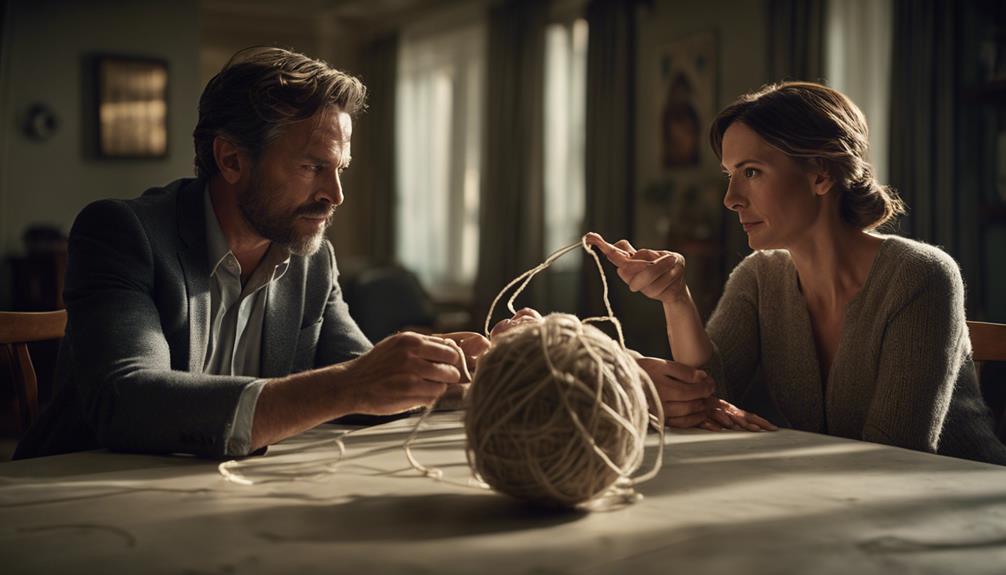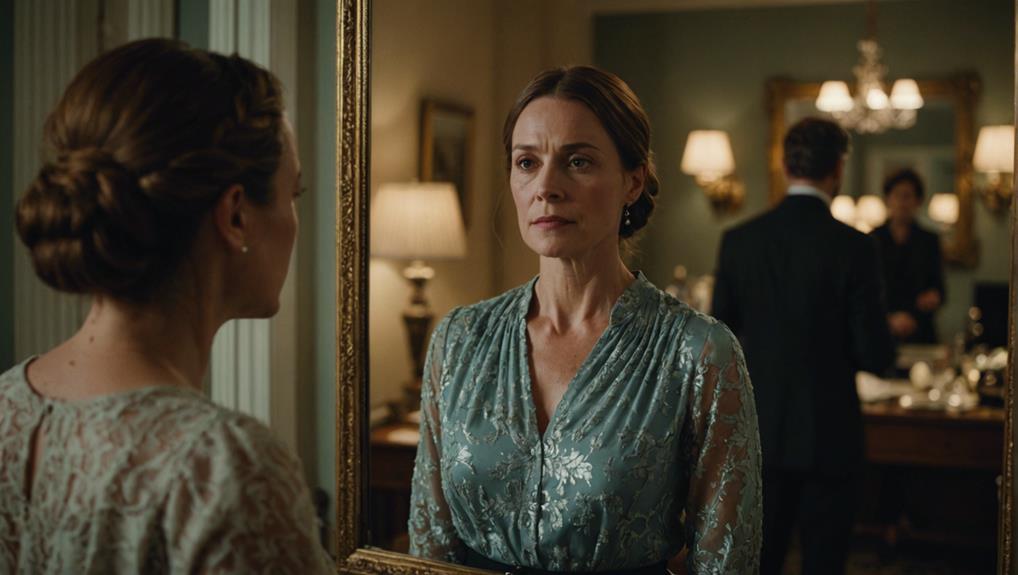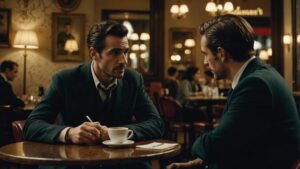In 'The Wife,' marriage complexities reveal societal norms and power dynamics of the Middle Ages. Gender roles, love, and duty intersect in a delicate balance, challenging traditional views. Communication hurdles and spiritual reflections add depth to partnerships portrayed through the lens of agency and critique. The Wife's assertiveness and manipulation expose a narrative woven with humor and satire, questioning cultural norms. Explore the intricate web of complexities shaping relationships in 'The Wife,' where layers of societal expectations and personal desires intertwine to offer a profound understanding of marriage dynamics.
Historical Context of Marriage
The historical context of marriage in 'The Wife' sheds light on the societal norms and gender roles prevalent in the Middle Ages. In medieval times, marriage wasn't solely based on romantic love but was often viewed as a social and economic contract. Gender roles played a significant role in shaping marital relationships during this period. Women were expected to be submissive and obedient to their husbands, while men held authority and dominance within the household.
These gender roles were deeply ingrained in medieval society, influenced by societal expectations, religious beliefs, and legal constraints. 'The Wife of Bath's Prologue' challenges these traditional views on marriage by presenting a complex perspective on marital relationships. By understanding the historical context of marriage in 'The Wife', one can better appreciate the complexities and nuances of relationships in medieval society.
The dynamics between husbands and wives were intricate, reflecting the multifaceted nature of marital unions during that era.
Gender Roles and Expectations
You can observe how 'The Wife' challenges traditional gender roles and societal expectations within marriage.
The Wife's assertiveness and independence go against the norms of passivity typically associated with women in relationships.
Through the Prologue, the text critiques patriarchal structures and emphasizes the Wife's agency in shaping her own narrative.
Traditional Gender Roles
Challenging societal norms, the Wife in 'The Wife of Bath's Prologue asserts her authority and independence in marriage. In a time when traditional gender roles dictated strict expectations within marriage, the Wife boldly defies these norms, paving the way for a new perspective on relationships.
Through her actions and words, she challenges the status quo and redefines the boundaries of gender roles in marriage.
Here are three vivid images to help you grasp the essence of the Wife's approach to traditional gender roles:
- Picture the Wife confidently speaking her mind, challenging the male-dominated narrative of marriage.
- Imagine her negotiating for her own desires and needs, disrupting the traditional power dynamics within the institution of marriage.
- Envision the Wife's unwavering determination to assert her autonomy, defying the constraints of societal expectations surrounding gender roles in marriage.
Societal Expectations in Marriage
In exploring societal expectations in marriage, consider the historical context that shaped traditional gender roles and expectations, particularly in the medieval era. During this time, married couples were often bound by strict gender roles, with husbands expected to be the primary providers and decision-makers, while wives were tasked with managing the household and caring for the family.
Additionally, expectations surrounding sex in marriage were heavily influenced by societal norms, often focusing on procreation and duty rather than personal desire or fulfillment.
The Wife of Bath challenges these societal norms by asserting her independence and control within her marriages. Through her character, Chaucer highlights the complexities and tensions that arise when individuals challenge traditional gender roles and expectations in marriage.
Concepts like the marital debt, consent, and freedom in partner choice were significant factors that influenced the dynamics of relationships during this period. By examining the Wife of Bath's Prologue, one can gain valuable insights into the limitations and expectations imposed by society on marriage and gender dynamics.
Communication Challenges in Relationships

You struggle to decipher between what your partner says and what they truly mean, often missing important nonverbal cues that reveal their true emotions.
Emotional barriers hinder your ability to express your thoughts openly, leading to a breakdown in communication and the escalation of conflicts.
Misunderstandings arise when unspoken expectations clash, creating tension and distance between you and your spouse.
Verbal Vs. Nonverbal Cues
Understanding the intricacies of communication in relationships involves comprehending the differences between verbal and nonverbal cues. In a relationship, verbal cues are the spoken words and language used to convey messages explicitly, while nonverbal cues encompass body language, facial expressions, and gestures that convey feelings subtly.
To navigate the complexities of communication in relationships effectively, it's essential to interpret both verbal and nonverbal cues accurately. Misinterpreting nonverbal cues can lead to misunderstandings and breakdowns in communication within relationships.
Here are three ways in which verbal and nonverbal cues play an important role in relationship dynamics:
- Verbal Cues: Imagine a couple having a candid conversation about their day, expressing their thoughts and feelings openly.
- Nonverbal Cues: Picture a scenario where one partner crosses their arms and avoids eye contact, indicating discomfort or disagreement.
- Interpreting Cues: Consider the importance of recognizing when verbal and nonverbal cues align or contradict each other to understand the true message being communicated.
Emotional Barriers Breakdown
Breaking down emotional barriers can greatly impact communication challenges in relationships. When emotional barriers exist, effective communication becomes difficult, leading to misunderstandings and conflicts.
Lack of open and honest expression of thoughts and feelings can create a sense of emotional distance between partners, hindering the growth and intimacy in a marriage.
To overcome communication breakdowns, it's vital to develop effective communication skills such as active listening and validating each other's feelings. Healthy communication involves not only expressing oneself but also understanding and empathizing with your partner's perspective.
By learning to communicate effectively, partners can strengthen their emotional connections and foster a deeper understanding of each other. Addressing communication challenges early on is essential to prevent them from escalating into larger issues that may strain the relationship.
Ultimately, breaking down emotional barriers is key to creating a foundation of trust and mutual respect in a marriage.
Misunderstandings and Conflicts
Emotional barriers and communication breakdowns can often pave the way for misunderstandings and conflicts in a marriage, impacting the overall intimacy and connection between partners.
When communication falters, conflicts may arise due to misinterpretations or unexpressed feelings.
Here are three key points to keep in mind when addressing communication challenges and conflicts in a relationship:
- Active Listening: Take the time to truly listen to your partner without interruptions or distractions, showing that you value their perspective and feelings.
- Clear Expression: Articulate your thoughts and emotions openly and honestly, fostering a transparent environment where both partners feel heard and understood.
- Empathy and Understanding: Make an effort to empathize with your partner's feelings and viewpoints, even if you may not fully agree, to bridge the gap in communication and prevent conflicts from escalating.
The Intersection of Love and Duty
Managing the intricate balance of love and duty within marriage can be a challenging endeavor. In the Wife of Bath's Prologue, the exploration of love in marriage challenges traditional views on the meaning of marriage. Through the character of the Wife, Chaucer explores the complexities of the intersection between personal desires and societal expectations in marriage.
The text presents a nuanced portrayal of how love can be seen as a duty and duty as an expression of love within the confines of marriage. The Wife's narrative sheds light on the intricate dynamics involved in maneuvering love, duty, and autonomy within the institution of marriage. It highlights the fine line individuals must walk between fulfilling their obligations to their partners and staying true to their own desires.
Ultimately, the Wife's story serves as a reflection of the intricate web of emotions and responsibilities that come with the union of marriage.
Navigating Power Dynamics in Marriage

The Wife of Bath's assertiveness and control over her husbands challenge traditional power dynamics in marriage, emphasizing the significance of female agency and autonomy within marital relationships. Within the intricate web of marriage relationships, power dynamics play a pivotal role in shaping the interactions between partners. Here are three ways in which the Wife maneuvers power dynamics in her marriages:
- Strategic Manipulation: The Wife strategically manipulates her husbands to gain control and assert her dominance in the marriage relationship.
- Reversal of Gender Roles: By reversing typical gender roles and power structures, the Wife challenges societal norms and expectations within marriage.
- Negotiation of Sovereignty: Her desire for sovereignty and independence showcases the ongoing negotiation of power within marital relationships.
Through her actions and decisions, the Wife of Bath illustrates the elaborate dance of power dynamics within marriage relationships, shedding light on the complexities that arise when handling authority and autonomy.
Deconstructing Cultural Myths About Marriage
Challenging entrenched beliefs and societal norms, the Wife of Bath in 'The Wife' skillfully dismantles cultural myths surrounding marriage. Through her character in Chaucer's 'The Canterbury Tales,' she critiques traditional views on gender roles within marriage, shedding light on power dynamics, sexual agency, and societal expectations prevalent in medieval marital relationships.
The Wife's narrative serves as a platform for exploring the complexities of marriage in her time, using humor and satire to deconstruct stereotypes and prompt reflection on evolving marital dynamics. By challenging these cultural myths, the Wife of Bath encourages a reevaluation of ingrained beliefs about marriage and the roles of individuals within it.
Her character's bold and outspoken nature challenges the status quo, inviting readers to reconsider preconceived notions about gender roles and relationships, ultimately contributing to a nuanced understanding of the multifaceted institution of marriage.
Spiritual Insights on Partnership

Exploring the spiritual dimensions of partnership in 'The Wife of Bath' sheds light on the deeper emotional and relational aspects of marriage. Through the Wife's narrative, readers are confronted with profound insights that challenge conventional notions of marriage and gender roles.
- The Wife's reflections on her multiple marriages highlight the complexities of human relationships and the ever-evolving nature of love within the sacred bond of marriage.
- Chaucer's portrayal of the Wife as a strong, independent woman who asserts her desires and challenges societal norms provides a nuanced perspective on the spiritual dynamics of partnership.
- By delving into the Wife's experiences, readers are encouraged to contemplate the role of God in guiding and shaping the intricate dance of marriage, inviting a deeper reflection on the divine presence within the intimate union of two souls.
In 'The Wife of Bath', marriage isn't merely a social contract but a spiritual journey that intertwines the earthly and the divine, offering profound lessons on love, resilience, and faith.
Conclusion
As you reflect on the complexities of marriage in 'The Wife', you may find yourself questioning long-held beliefs about love and duty.
The truth is, marriage is a multifaceted institution that requires constant communication, understanding, and compromise.
By examining cultural myths and analyzing power dynamics, you can gain a deeper insight into the true nature of partnership.
So, the next time you explore a story about marriage, remember to investigate the layers beyond the surface.



